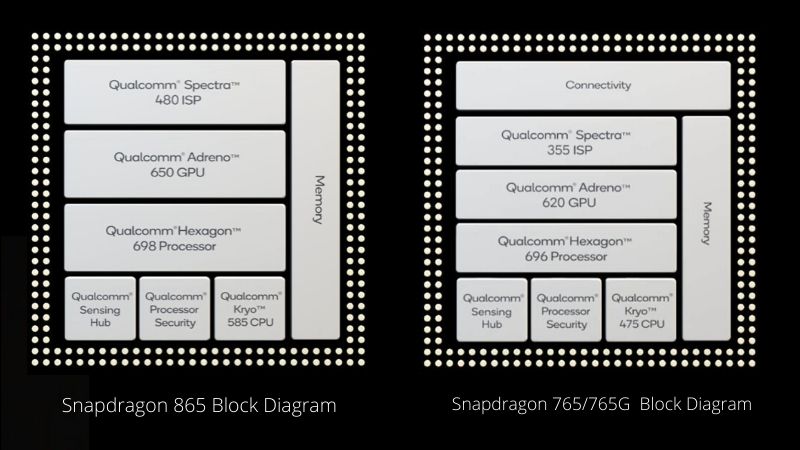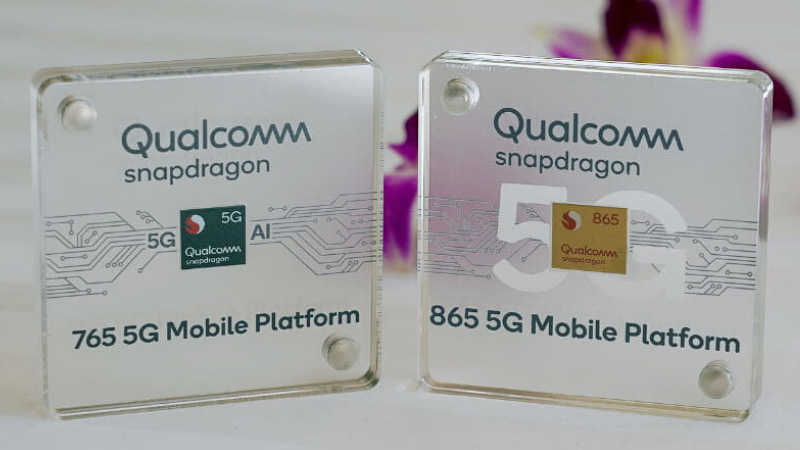Qualcomm President Cristiano Amon announced their new mobile processor line on December 3, 2019, at the Annual Snapdragon Tech Summit 2019 in Hawaii. The latest chipsets include Snapdragon 865, Snapdragon 765 and Snapdragon 765G. As the 865 SoC is Qualcomm’s flagship processor, the Snapdragon 865 will beat both the Snapdragon 765 and 765G in terms of performance. So, here we will not tell you which processor is the best of the three SoCs but will compare their specifications and advantages.
Snapdragon 865 vs 765 vs 765G Comparison
Process:
All three SoCs are manufactured using a 7nm process. But, Snapdragon 865 is built on TSMC’s 2nd generation 7nm+ node while both Snapdragon 765 and 765G use a 7 nm EUV fabrication process from Samsung.
CPU:
Snapdragon 865 uses a 1+3+4 core combination on its CPU that includes one Kryo 585 (ARM Cortex A77) prime core clocked at 2.84GHz. There are three Kryo 585 (ARM Cortex A77) performance cores at 2.4GHz. The remaining four efficiency cores, i.e., Kryo 385 (ARM Cortex A55), clocked at 1.8GHz. On the other hand, we have one primary Kryo 475 core on Snapdragon 765, based on ARM Cortex-A76 and clocked at 2.3GHz. Snapdragon 765G also has the same single prime core, which is clocked at 2.4GHz. The remaining 7 cores of both SoCs are the same, which includes one Kryo 475 (ARM Cortex-A76) core at 2.2GHz for mid-performance and six ARM Cortex-A55 efficiency cores at 1.8GHz.

5G Modem:
All three processors are 5G ready. The new flagship Snapdragon 865 SoC comes with a separate 2nd Gen Snapdragon X55 modem-RF (radio frequency) system, whereas both higher mid-range processors, Snapdragon 765 and 765G, come with integrated X52 5G modem. A separate 5G modem means more expensive and power-hungry smartphones than a built-in or integrated solution. So, Snapdragon 765/765 G’s integrated 5G solution brings an advantage in case of lower power consumption.
Network:
In terms of download speed and network support, the X52 5G modem on Snapdragon 765 & 765G provides a download speed of up to 3.7 Gbps and supports mmWave, Sub-6-GHz, SA/NSA dual-mode 5G, TDD & FDD. On the other hand, the 2nd Gen X55 5G modem on Snapdragon 865 provides download speeds up to 7.5 Gbps and supports sub-6 GHz, mmWave, NSA, SA, TDD & FDD.
AI Performance:
The Snapdragon 865 has Hexagon 698 with a 5th Gen AI Engine that provides 15 TOPS (Trillion Operations per Second) AI performance. Qualcomm says the Snapdragon 865 SoC’s AI performance is double compared to their previous flagship Snapdragon 855 SoC, which has the 4th Gen AI Engine. On the other hand, 765 & 765G comes with Hexagon 698 with a 5th Gen AI Engine that provides 5.5 TOPS (765G) AI performance.
Camera:
The flagship Qualcomm chipset 865’s Dual 14-bit Spectra 480 ISP supports cameras up to 200MP in resolution. Also, it supports 8K 30FPS video, 64MP 4K video, Dolby Vision video capture, Unlimited 960FPS video capture, and 2 Gigapixel per second ISP processing. On the other hand, a Dual 14-bit Spectra 355 ISP on a 765/ 765G chipset supports a single camera of up to 36MP with ZSL or Up to 192MP and a dual camera of up to 22MP with ZSL. Also, it supports 4K HDR @ 30 fps video and slow motion up to 720p @ 480 fps.
GPU:
In GPU performance, the Snapdragon 865 SoC’s Adreno GPU 650 is 25% more powerful than its predecessor. It supports Qualcomm’s Elite Gaming Suite for an improved gaming experience. At the same time, both Snapdragon 765 & 765G come with the latest Adreno 620 GPU that brings 20% better performance and efficiency. As the 765G is a gaming-centric processor, we will see some of the features of the Elite Gaming Suite. Also, the 765G offers 10% faster graphics rendering than the Snapdragon 765.
Specifications Table to Find Out Differences
| SoC | Snapdragon 865 | Snapdragon 765 | Snapdragon 765G |
| Process | 7nm+ from TSMC | 7nm EUV from Samsung | 7nm EUV from Samsung |
| CPU | 1x Kryo 585 (ARM Cortex A77) Prime core @ 2.84GHz 3x Kryo 585 (ARM Cortex A77) Performance cores @ 2.4GHz 4x Kryo 385 (ARM Cortex A55) Efficiency cores @ 1.8GHz | 1x Kryo 475 (ARM Cortex-A76) Prime core @ 2.3GHz 1x Kryo 475 (ARM Cortex-A76) Performance core @ 2.2GHz 6x (ARM Cortex-A55) Efficiency cores @ 1.8GHz | 1x Kryo 475 (ARM Cortex-A76) Prime core @ 2.4GHz 1x Kryo 475 (ARM Cortex-A76) Performance core @ 2.2GHz 6x (ARM Cortex-A55) Efficiency cores @ 1.8GHz |
| GPU | Adreno 650 Vulkan 1.1 | Adreno 620 Vulkan 1.1 | Adreno 620 Vulkan 1.1 |
| Modem | X55 5G Modem | X52 5G Modem | X52 5G Modem |
| AI | Hexagon 698 Processor 15 TOPS | Hexagon 696 Processor ? TOPS | Hexagon 696 Processor 5.5 TOPS |
| Imaging | Qualcomm Spectra 480 | Qualcomm Spectra 355 | Qualcomm Spectra 355 |
| Camera | Single Upto 200MP | Single Upto 192MP | Single Upto 192MP |
| Charging | Qualcomm Quick Charge 4+ Qualcomm Quick Charge AI | Qualcomm Quick Charge 4+ Qualcomm Quick Charge AI | Qualcomm Quick Charge 4+ Qualcomm Quick Charge AI |
| Display | Maximum On-Device Display Support: UHD @ 60Hz, QHD+ @ 144Hz Maximum External Display Support: UHD @ 60Hz HDR support | Maximum On-Device Display Support: FHD+ @ 120Hz, QHD+ @ 60Hz Maximum External Display Support: UHD @ 60Hz HDR support | Maximum On-Device Display Support: FHD+ @ 120Hz, QHD+ @ 60Hz Maximum External Display Support: UHD @ 60Hz HDR support |


